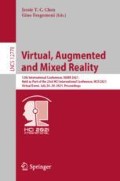Abstract
The Augmented (AR), Mixed (MR) and Virtual Reality (VR) technologies, here subsumed as “xR”, have matured in the last years. The research focus of this paper is to study interaction on four different xR platforms to improve medical applications in the future. Often medical applications could be created either as VR or AR scenario. It may depend on multiple factors which xR platform should be used in a specific use case. Therefore, it is interesting to know if there are any differences in usability or user experience between those.
There are various manipulation possibilities that can be done with a virtual object in xR. These major interaction possibilities are explored here: addressing, grasping, moving and releasing of objects. We use a specific virtual scenario to assess user experience and usability of the aforementioned interactions on the four xR platforms. We compare differences and commonalities of the way the interactions are achieved on all platforms.
A study with twenty-one participants gives insight on three main aspects: First, even though the used four platforms have very different interaction capabilities, they can be suitable for biomedical training tasks. Second, all four platforms result in high usability and user experience scores. Third, the HoloLens 2 was the most attractive device but usability and user experience stayed lower in some aspects than even the very simple VR Cardboard.
Access this chapter
Tax calculation will be finalised at checkout
Purchases are for personal use only
References
Alberola, C., Walter, G., Brau, H.: Creation of a short version of the user experience questionnaire UEQ. i-com 17(1), 57–64 (2018)
Aliprantis, J., Konstantakis, M., Nikopoulou, R., Mylonas, P., Caridakis, G.: Natural interaction in augmented reality context. In: VIPERC@ IRCDL, pp. 50–61 (2019)
Bowman, D.A., Hodges, L.F.: An evaluation of techniques for grabbing and manipulating remote objects in immersive virtual environments. In: Proceedings of the 1997 Symposium on Interactive 3D Graphics, p. 35ff (1997)
Hürst, W., Van Wezel, C.: Gesture-based interaction via finger tracking for mobile augmented reality. Multimedia Tools Appl. 62(1), 233–258 (2013)
Khor, W.S., Baker, B., Amin, K., Chan, A., Patel, K., Wong, J.: Augmented and virtual reality in surgery–the digital surgical environment: applications, limitations and legal pitfalls. Ann. Transl. Med. 4(23) (2016)
Laugwitz, B., Held, T., Schrepp, M.: Construction and evaluation of a user experience questionnaire. In: Holzinger, A. (ed.) USAB 2008. LNCS, vol. 5298, pp. 63–76. Springer, Heidelberg (2008). https://doi.org/10.1007/978-3-540-89350-9_6
Milgram, P., Takemura, H., Utsumi, A., Kishino, F.: Augmented reality: a class of displays on the reality-virtuality continuum. In: Telemanipulator and Telepresence Technologies, vol. 2351, pp. 282–292. International Society for Optics and Photonics (1995)
Oh, J.Y., Park, J.H., Park, J.M.: Virtual object manipulation by combining touch and head interactions for mobile augmented reality. Appl. Sci. 9(14), 2933 (2019)
Pantelidis, P., et al.: Virtual and augmented reality in medical education. In: Medical and Surgical Education-Past, Present and Future, pp. 77–97 (2018)
Pradini, R.S., Kriswibowo, R., Ramdani, F.: Usability evaluation on the sipr website uses the system usability scale and net promoter score. In: 2019 International Conference on Sustainable Information Engineering and Technology (SIET), pp. 280–284. IEEE (2019)
Preece, D., Williams, S.B., Lam, R., Weller, R.: “Let’s get physical”: advantages of a physical model over 3D computer models and textbooks in learning imaging anatomy. Anat. Sci. Educ. 6(4), 216–224 (2013)
Pujol, S., Baldwin, M., Nassiri, J., Kikinis, R., Shaffer, K.: Using 3D modeling techniques to enhance teaching of difficult anatomical concepts. Acad. Radiol. 23(4), 507–516 (2016)
Sauro, J.: Measuring usability with the system usability scale (SUS) (2011). https://measuringu.com/sus/
Schrepp, M.: User Experience Questionnaire Handbook (2019). https://www.ueq-online.org/Material/Handbook.pdf
Sutherland, J., et al.: Applying modern virtual and augmented reality technologies to medical images and models. J. Digit. Imaging 32(1), 38–53 (2019)
Veldhuizen, M., Yang, X.: The effect of semi-transparent and interpenetrable hands on object manipulation in virtual reality. IEEE Access 9, 17572–17583 (2021)
Weschke, D.: UEQ-user experience questionnaire: the UX testing tool that was here all this time-for free (2019)
Will, T.: Measuring and interpreting system usability scale (SUS) (2017). https://uiuxtrend.com/measuring-system-usability-scale-sus/
Author information
Authors and Affiliations
Corresponding author
Editor information
Editors and Affiliations
Rights and permissions
Copyright information
© 2021 Springer Nature Switzerland AG
About this paper
Cite this paper
Balani, M.S., Tümler, J. (2021). Usability and User Experience of Interactions on VR-PC, HoloLens 2, VR Cardboard and AR Smartphone in a Biomedical Application. In: Chen, J.Y.C., Fragomeni, G. (eds) Virtual, Augmented and Mixed Reality. HCII 2021. Lecture Notes in Computer Science(), vol 12770. Springer, Cham. https://doi.org/10.1007/978-3-030-77599-5_20
Download citation
DOI: https://doi.org/10.1007/978-3-030-77599-5_20
Published:
Publisher Name: Springer, Cham
Print ISBN: 978-3-030-77598-8
Online ISBN: 978-3-030-77599-5
eBook Packages: Computer ScienceComputer Science (R0)

